The Battle of Beta-Garmon is the second book in the Campaigns of the Age of Darkness series for the Horus Heresy. It follows The Siege of Cthonia, with which it shares a general format and actually a few pages of duplicated content covering campaign rules and Core Missions.
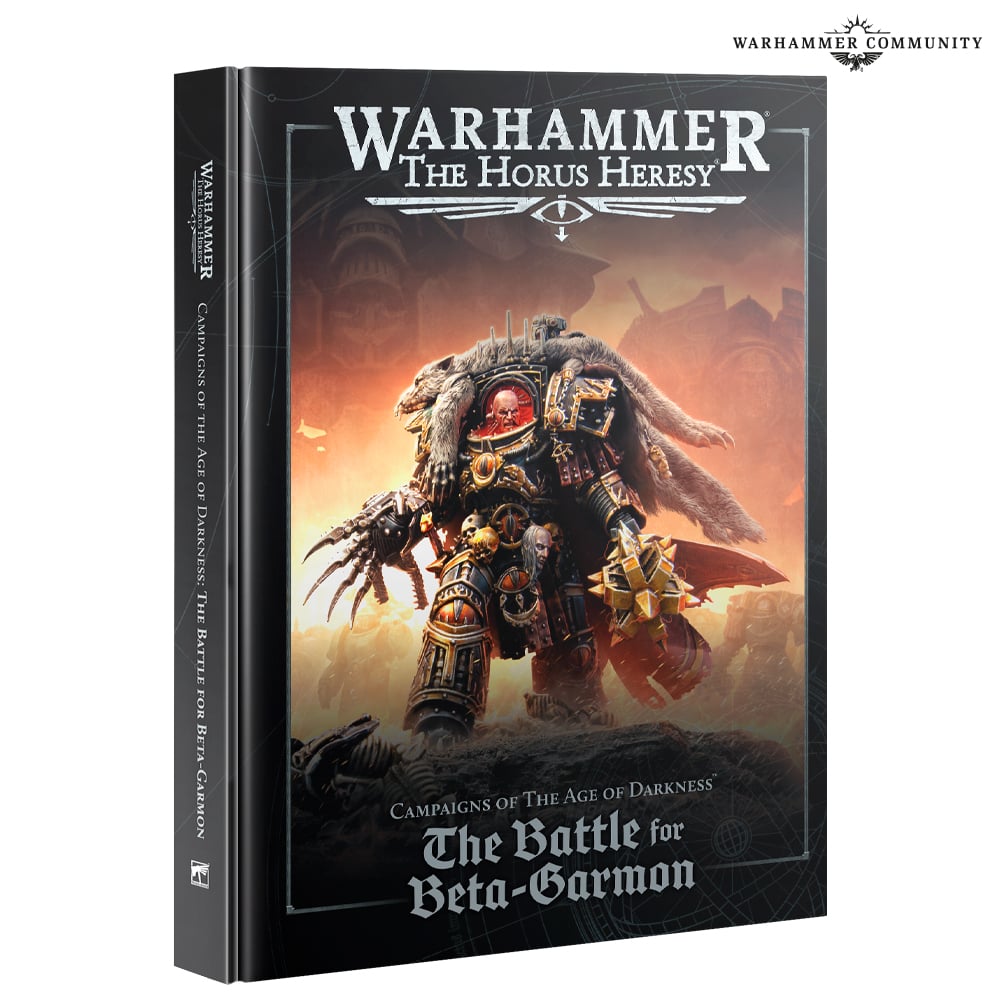
There’s also a lot of new content. Almost the first half of the book is background covering the Great Slaughter at the Garmon Cluster. This is followed by that campaign system with some new Stratagems and Apex Missions, then a lot of new rules for Shattered Legions, Blackshields and Legiones Auxilia. There are also a few new units for the Solar Auxilia the Legions.
Thanks to Games Workshop for providing us with a copy of these rules to review.
Table of Contents
Background
This is well worth reading to understand what this fight was all about and what ended up happening there. Basically, Beta Garmon was an incredible meat grinder of a campaign that sucked in loads of resources from both sides, up to and including Titan Legions, and hardly anyone who went there ever left. There are some nice colour plates though sadly many of the stories attached to them finish by saying that the Legionary or Auxiliary pictured either vanished altogether or met an end so violent that they could only be identified by dental records.
Campaigns of the Age of Darkness: The Garmon Bulwark
See our review of Siege of Cthonia for our thoughts on the Onslaught Campaign System and the Age of Darkness Core Missions, intended for both Narrative and Matched Play. Reprinting them here is fine as it means you don’t need to carry both Siege of Cthonia and this book around with you, but there’s no need to review them again.
The difference here is that we get some optional rules Stratagems and Apex missions specifically intended to recreate the events of the Garmon Bulwark campaign. The Mortification Index and The March of the Angel are your two special rules and both can give the Loyalists a bonus or penalty to their Strategic Advantage rolls depending on how the campaign is going so far.
Campaign Stratagems include The Ragged and Forgotten, which lets you field an extra allied detachment of Blackshields or Shattered Legions (which can’t usually be allies, but whatever). They get Hatred of one faction in the enemy army. Void Superiority lets you delay enemy reserves or speed up your own. The Great Slaughter has your army beset by madness so they can’t claim objectives for a turn but you get a VP for every unit, on either side, that is removed as casualties.
There are two Apex Missions. Clash Atop the Ghal-Zammad starts with a Primarch on each side fighting alone in the middle of the battlefield while everyone else rushes to help. Across the Fields of Dead has a defender trying to escape across a mined battlefield while the attacker harries their flanks. Both look like they’d be quite fun to play but they are definitely “out there” as major departures from the Core Missions.
The Shattered Legions
These are the most thought-provoking rules I’ve seen in some time. Foremost among those thoughts is the question, “How and why did this happen?” because these rules don’t seem playable. Oddly, the designers seem to think the same, so they’ve given us a big note at the start of this section warning us not to use these rules in a competitive environment or when time is a factor. Time is a factor at narrative events and even club nights, assuming you get chucked out at some point, so for me this pretty much rules out the army.
And that’s not good enough. These are printed rules in a book you have to pay for. They represent a faction that has tons of cool backstory, going all the way from Istvaan III to the Siege and much in between. Many players, myself included, would like to build this army, but these rules would make it a waste of time as we could hardly ever field them. We don’t need perfectly-balanced tournament rules but we do want to be able to play a full game where both players can understand what’s going on.
The rules start out reasonably. A Shattered Legion detachment is made up of two or three Legions, which can be any of the 18 we know about. So you might pick Space Wolves, Death Guard and Iron Hands, and all your models would represent former members of those Legions. It must be your primary detachment and you can’t include any other detachments – meaning no allies or Lords of War. You also aren’t allowed a Primarch.
Shattered Legion armies can have Veteran Squads as Troops and they get Line. Any unit (not just Veterans) that takes a Dedicated Transport is a Support Squad, so can’t fill compulsory slots. You can’t have any units or upgrades that are restricted to individual Legions, except that Independent Characters can buy equipment from whatever Legion they’re from. There are no Warlord Traits for the Shattered Legions and no Advanced Reaction, which is kind of a shame.
But now we reach something called Mutable Tactics, which is the equivalent of Legion rules for Shattered Legions. Mutable Tactics generates special rules that can be different for each unit in your force and need to be checked every phase because they may well have changed. This will result in a vast and totally unnecessary amount of bookkeeping and confusion as you constantly check – or in some cases choose – what rules each unit in your army has during every phase of your turn and your opponent’s.
When you put your army together every unit must have at least one member of each of your Legions. Using the example above you’d need a Space Wolf, a Death Guard and an Iron Hand as the first three members of any unit and then be able to fill it up with whoever you liked. Every individual model must belong to one of your 2-3 Legions or to no identifiable Legion – which causes some other problems as we’ll see later.
At the start of each phase you count up the models in a unit to see which Legion has the most models (called the Majority) and which has the least (called the Minority), ignoring the middle Legion and any models whose Legion can’t be identified.
If a unit has an equal number of models from multiple Legions as either Majority or Minority then the owner gets to pick which benefits and penalties apply. This is problematic as it gives you enormous flexibility and will come up quite a lot. Units of three are quite common for things like jetbikes. An unscrupulous player could make units with one member from each of their Legions and everyone else unidentifiable, giving them a free choice of rules – at least until enemy snipers intervene and kill off some of their choices.

The unit above has four Raven Guard, four Iron Hands and two Salamanders. Every phase its owner can choose whether to count Raven Guard or Iron Hands as the Majority. Salamanders will be the Minority until a couple of Raven Guard or Iron Hands are removed.
Once you’ve figured out a unit’s Majority and Minority Legions are you can look up what its special rules will be for that phase. A unit gets a Major trait from the Majority Legion plus a Minor trait and flaw from the minority. If we have a unit of 10 models with 5 Space Wolves, 3 Death Guard and 2 Iron Hands the Wolves are in the Majority, the Iron Hands are the Minority and the Death Guard are ignored. If 3 of the Wolves were to die then the Death Guard would be Majority and the owner would get to choose each turn whether the two remaining Wolves or the Iron Hands were the Minority.
What this means is that your units’ rules change all the time as they suffer casualties. The models you (or perhaps your opponent) remove from your units will affect which Legions are the Majority and Minority, causing the unit’s rules to change. If you’re playing with three Legions, each with a Major trait, Minor trait and a flaw, you’ll have to remember nine special rules. Each of your units will possess three of them at any given moment, plus of course your Hero traits.
The Traits themselves are nice, mostly. They’re thematic and they certainly haven’t been shy about handing out good stuff with the Major ones. Imperial Fists get +1 to wound with bolt pistols, combi-bolters and bolters. Space Wolves get +1 to Wound on a turn when they charge and Death Guard, though not their vehicles and artillery, count as Stationary for Shooting if they move under 7”.
Minor traits do less but are still significant. They are effectively paired with Flaws, which can be highly significant. Combined they will make a big difference to the unit, which is a bit odd considering there will often just one or two members of the Minority Legion in a unit. Ultramarines get +1 to hit on reactions but have to pass a LD check to actually make a reaction, though the reaction point isn’t wasted if they fail. Outnumbered Sons of Horus get +1 to hit in melee but aren’t eligible to make reactions against units they themselves outnumber. Word Bearers get to roll an extra D6 and discard one for Morale and Pinning checks but take a Wound if they fail.
Taken on their own I like the Traits and Flaws they’ve produced. They’re thematic and interesting and if they didn’t constantly change they’d be a pretty cool way of representing units made up of different Legions. I think there’s scope here for someone to produce a House-ruled version – most obviously just fixing the rules for each unit at the start of the game – that could work quite nicely.
There are other problems beyond the bookkeeping. A unit of three, or with two Legions equal in the minority, can simply swap which traits apply any time they are inconvenient. If it’s the assault phase and you don’t want your Blood Angels Flaw to force you to declare a charge, just count as Iron Hands for that phase instead. You’ll get a flaw preventing you from running, which only matters during the movement phase, when you can switch back to being a Blood Angel. If you can choose which flaw applies then you may as well not have a flaw at all.
Single-model units like Dreadnoughts and vehicles, or units that include models from only a single Legion, just get the minor benefit and flaw of their Legion. They never get the Major benefit. The good news is there isn’t much bookkeeping to do but unfortunately these benefits and flaws don’t seem to have been designed with single-model units in mind. Several Minor Traits and Flaws have no effect on single-model units because of their other traits, the equipment they have and so on. Others are excellent, or devastatingly bad.
The most dramatic is probably Night Lords, whose flaw is that they aren’t allowed to declare a charge unless they outnumber the target unit. A Dreadnought just counts as one model, meaning it will never outnumber anything and is unable to charge, ever! On the other hand A Sons of Horus Dreadnought is going to enjoy being outnumbered nearly all the time in melee, as it then gets +1 to hit.
The Iron Hands Minor trait is that Iron Hands models in the unit get 5+ FNP. That’s no big deal if one or two models in a Tactical Squad have it, but it’s a huge buff for a Leviathan. That’s paired with a Flaw that the unit can’t run or make sweeping advances, which is quite a problem for an infantry unit but not really for the Leviathan, which already can’t run.
Independent Characters get Hero traits, typically granting them a special rule. These are mostly things that help them as individuals, like Iron Hands getting IWND 4+ and Blood Angels getting Furious Charge. Ultramarines and Word Bearers get Stubborn though, which will significantly benefit units they’re leading. They also count to determine the Majority and Minority Legions of any unit they join, potentially changing its rules in subsequent phases. They benefit and suffer from the rules of their unit.
I find these rules hugely disappointing. I wouldn’t mind the impractical bookkeeping quite so much if the rules seemed like an over-realistic simulation or something like that, as there’s a time and place for that kind of thing. Instead I just think it’s silly. Legionaries wouldn’t constantly be holding votes on how they should behave in the middle of a firefight. A unit made up of Legionaries might combine their experience to good effect, or else argue about how best to proceed, but this doesn’t seem to replicate that at all.
The end result is a set of rules that aren’t practical, fun or realistic. Another Goonhammer contributor described them as a piece of performance art and that might be about right. My own take is that somebody senior in the design team really likes the Mutable Tactics rule and is forcing it through even though they haven’t managed to get it to work. Nobody had the courage to say they needed to go back and try again and this is the result.
I’m glad to say that the rest of the book is a lot better than this.
Blackshields
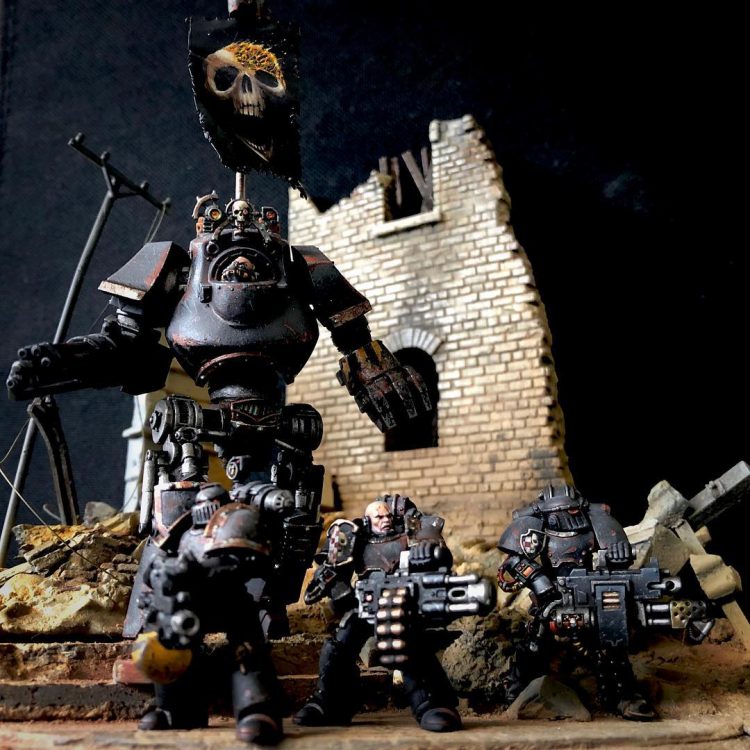
I’m happy, though surprised, to report that the rules for Blackshields are nothing at all like those for Shattered Legions. They seem perfectly workable and lots of fun, particularly for people interested in creating their own narrative or major modelling projects. We don’t get any sort of disclaimer about these rules so it looks like they’re intended for all types of play.
Blackshields have both the Loyalist and Traitor Allegiance if you take them as your Primary Detachment. Otherwise they have the Allegiance of the Primary Detachment. They can’t be used alongside Talons of the Emperor like Custodes or Sisters of Silence. You also can’t use Rites of War or any Legion-specific equipment or units.
We get an Advanced Reaction called No Lords, No Masters, which you can trigger if one of your units gets charged by an enemy Primarch, unique model, Master of the Legion or Warlord. Your unit becomes Fearless for the duration of the combat and its models get +1A if in base contact or a challenge with an enemy Character, or +2A if they’re Unique.
There are three Warlord Traits. A Bloody Tyrant has Fear (1), affecting friends as well as enemies. If one of your units in his aura gets pinned or falls back (which is more likely thanks to his Fear) he can choose to kill one of them, meaning the rest of the unit stays in the fight.
Forgotten Hero grants the Warlord’s unit +1WS and +1S until they next fight in melee if a wound is allocated to your Warlord during a shooting phase, whether or not the wound is saved and even if the Warlord dies. This is a bit odd in practice as it forces your opponent to either leave your unit alone or try to wipe it out. In either of those cases the trait doesn’t do anything, but deterring chip damage on your unit, or attempts to snipe your Warlord, is useful.
Twisted Strategist lets you give a single unit in your army Shrouded 6+), Rampage (1), Counter-attack (1) or Precision Shots (6+) for the duration of a battle round. You can only use each bonus once and one bonus per turn and your Warlord needs to be on the battlefield at the start of the battle round.
The fun really starts with Oaths of Vengeance and Wrath, which are the equivalent of Blackshield Legion Traits. You can pick up to two of them to represent the characteristics of your force. The designers have pushed the boat way, way out with some of these, which is awesome. There’s a note saying you shouldn’t chop and change these to suit your opponent, though in most cases the impacts are so huge that it would be difficult to do that.
One that you definitely shouldn’t tailor to each opponent is The Eternal Vendetta. You pick a single Legion and you get +1 to hit them in melee, though you have to try and charge them if you’re within 12″. This actually isn’t a huge bonus and won’t kick in that often, so it’s possibly something to pick if you aren’t sure what to do for a second Oath.
Some Oaths are relatively tame, though still characterful. Panoply of Old that lets you access one Legion’s Wargear options while The Spoils of Victory lets you loot fallen enemies who flee melee, getting a VP on a 4+ instead of chasing them down.
On the more extreme end of the scale, The Flesh Is Weak replaces the Infantry or Cavalry unit types with Automata and Feel No Pain (5+) rules, while also forcing your units to shoot at the nearest enemy unit they can hurt. The Legacy of Nikaea makes all your Characters Psykers, with a new Warp Torrent power that can be boosted to AP3 by taking Perils before attacking.
The Broken Helix represents forces that have gone a bit too far with their attempts to produce more Legionaries, producing either Clones or Aberrant mutants. Clones lose a point of initiative and LD in exchange for a 5+ damage mitigation, can’t be pinned but also can’t make reactions. Aberrants get +1S but -1BS, plus another point of Strength if they charge – which they must do if they can.
And there are plenty more. One Oath has units consolidate if they fail a morale check instead of falling back, but they suffer wounds if they don’t fight in melee every turn after the first. Another, representing warriors sworn to die to the last, loses D3 wounds instead of taking LD checks and gives away no VPs if killed. There’s an oath that removes all your HQ slots and gives you no Warlord but buffs all your Sergeants. Another removes all your troop slots(!) but gives you two more elites and gives Veterans Line, Heart and Fury of the Legion – for 50 points per unit. One lets you use weird (and fairly bad I think) Xenos weapons while another has your Legionaries use scrounged lasguns, shotguns and stubcarbines – one in each hand as pistols.
I’m sure this isn’t all that well-balanced and that there’s stuff here that’s a bit too powerful, but from a narrative perspective it’s fantastic. You can have an army of clones who’ve risen up, killed off their officers and struck out on their own – perhaps using the same head for anyone not wearing a helmet. You can have lobotomised automata set to zerg across the battlefield or desperate survivors using any weapons they can find and scrounging equipment from the fallen.
In theory these rules are intended to be used for allied detachments. You could certainly do that, but I think you could make a full army of them if you wanted. There are certainly limitations here but you have access to the whole Legion army list so there’s nothing stopping you filling out an army.
I’m not sure Blackshields and Shattered Legions really needed separate rules. Both are kind of the same thing – bands of legionaries from various legions fighting together. There’s some background fluff and stuff around allegiances but otherwise you could swap the names of the two sections and they’d work fine the other way around. Instead of spending a vast amount of energy writing unplayable Shattered Legion rules they could have just written a few more Oaths in this section, letting you use them to represent Shattered Legions. I think it would be perfectly reasonable to use these rules to represent a Shattered Legion army.
Legion Auxilia
Currently the Solar Auxilia doesn’t have any equivalent of Legion Traits and has no Warlord Traits or Advanced reaction. These rules don’t address that, which is a shame. Hopefully a future supplement will add a bit more flavour to the core Solar Auxilia list.
Instead, these are some fairly minor changes, adding some flavour and minor mechanical bonuses when Solar Auxilia forces are used as an Allied Detachment for the Legions and they represent troops who’ve been fighting alongside a Legion for a while, picking up various traits from it. They aren’t earth-shattering changes but they’re quite nice in their own right.
If your allied detachment is Solar Auxilia and your Warlord has the Legiones Astartes (X) rule, then you can choose to make them Legion Auxilia. They don’t work with Shattered Legions, Blackshields or Legiones Hereticus.
You get the trait associated with the Warlord’s Legion, affecting all units in the allied detachment, and a couple of other bonuses too. Both factions treat each other as Fellow Warriors, unless they were already Sworn Brothers, so all your Line units can score objectives. If Auxiliaries fail a Morale test while within 12″ of a Legionary they become pinned. They don’t actually say this overrides having to Fall Back, but I think that’s what they must mean or else it would do nothing, as pinning is removed when you fall back.
There’s a Trait for every Legion so I won’t go through them all. Some are simple, like Imperial Fist Auxiliaries with Line getting +1 to cover saves or World Eater Auxiliaries getting +1 to hit against units which are falling back or that have suffered casualties – which is a pretty major bonus.
Other traits require coordination between Legionaries and Auxiliaries. Blood Angel Auxiliaries get +1A if there’s a Blood Angel Legionary within 6″, making units like Veletarii with axes significantly better. If you can line up Night Lords Auxiliaries with a friendly model that causes Fear within 12″, they go a bit nuts and get Rage (2) for the duration of the assault phase. And as you’d expect, Ultramarine Auxiliaries are trained to provide close fire support, so if they can kill a model its unit can only fire snap shots at charging Ultramarines that turn. Raven Guard Auxiliaries get +1LD if they can see a Raven Guard, which I think lets you have Stubborn LD12 in a Reborn Cohort.
I like these rules a lot. I think they do the perfect job of encouraging us all to go out and get an allied detachment of Solar Auxilia to work with our existing Legion armies. Now let’s see the same thing done for Solar Auxilia primary detachments.
New Solar Auxilia Units
Cohort Doctrine: Reconnaissance Pattern Cohorts
Perhaps surprisingly, or perhaps not given the units that make up the rest of this section, we get a new Cohort Doctrine. It lets you take loads of the new Sentinels.
You get to take Hermes Light Sentinel Squadrons as Troops and those that fill compulsory slots get Line. Something called Veletaris Assault Squadrons get outflank, but there’s currently nothing with that name. Maybe they mean the new Veletaris Sentinels but I’m not sure. And Aethons can be taken in units of up to 5.
The only downside is that you can only include one Armoured Tercio and one Artillery Tercio. That’s not a huge issue, especially for an allied detachment with only one HS slot. You can still take 10 Leman Russes in one of those Tercios, which is likely to be enough.
Solar Auxilia Lifeward Section

This is a unit of two to ten bodyguards for your Legate Marshal. It works much like a Legion Command Squad in that your Legate gets permanently attached to the squad, which comes as part of the same HQ choice as him. Unfortunately Lifewards are normal humans – albeit very skilled ones – rather than the elite of the Astartes Legions. These guys do their best but they can’t really match up to the Legionaries and unfortunately they cost about the same amount of points.
Lifewards get a pretty good set of equipment with a Lasrifle, pistol and close combat weapon. They have 3+ armour saves and 5+ invulnerables from refractor fields. They’re all Chosen Warriors so they will step up and accept challenges on your Legate Marshal’s behalf. Their pistol and sword can be replaced with all sorts of fun options you can find on the new command sprue but you can’t exchange their Lasrifles for anything. Unlike Companions you can’t set this unit up with a load of plasma guns, though pistols are an option. I think these upgrades are over-priced, so for example Lifewards pay 10 points for a Power Weapon where equivalent Legion units only pay 5.
I think setting these guys up as a melee unit is probably a mistake. They’re fairly good in melee but many, many of the units they might have to face are better than them. Solar Auxilia don’t have access to an assault transport so you don’t have a delivery mechanism for them. Fundamentally, sending your Legate Marshal towards the enemy puts them in danger, when they’re the one model in your army you most want to protect.
Other key equipment they can have includes a Cohorts Vexilla to make them Line and a Command Vox to spread the Legate Marshal’s LD around. The best value use of the unit may be to just take a couple of them with the Vexilla and Vox, then put them in reserve or somewhere else as safe as possible. They can spend the game buffing the LD of your riflemen and possibly turn up to snatch an objective around the end of the game. There are already units you can do this with but they tend to be part of Tercios and that makes them a little unwieldy as they need to operate with the Tercio’s other units.
Solar Auxilia Hermes Light Sentinel Squadron
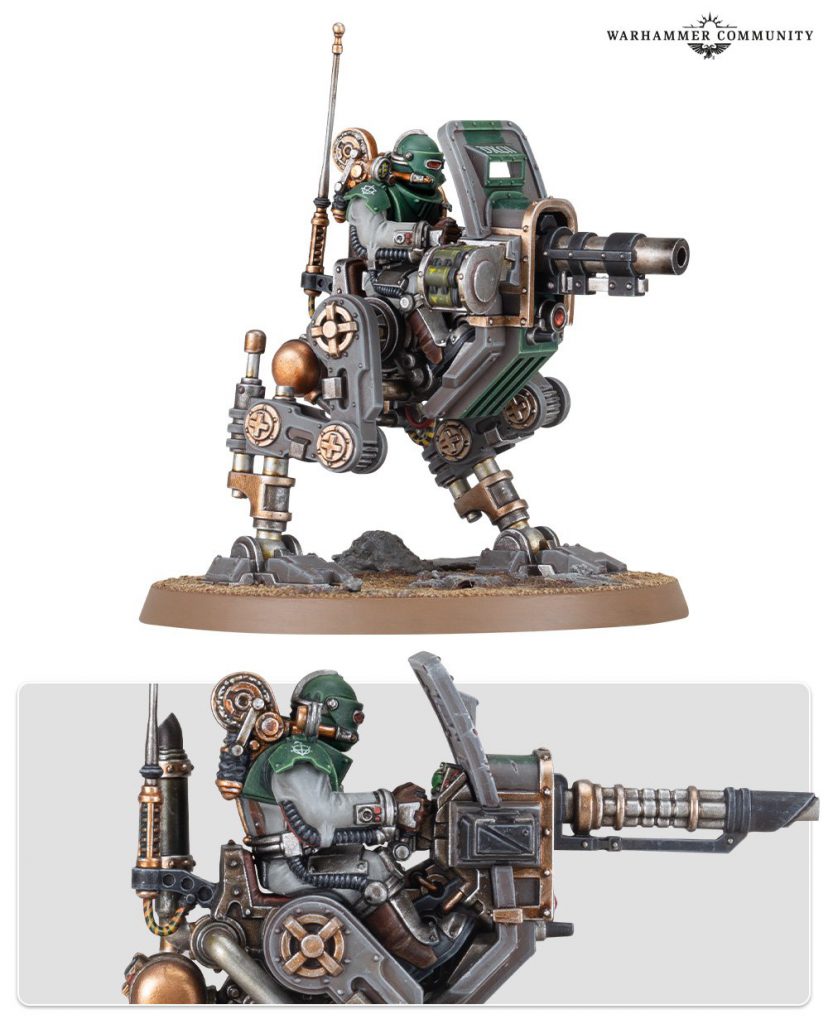
These are adorable and I won’t hear anything said against them. You get two to six as a Fast Attack choice. They’re Cavalry (Mechanised) with a 10” move, 2 wounds, T5 and a 4+ save, so they can get places but won’t survive long against any serious opposition. They have multilasers with BS3, which suits their thematic role as recon units chipping away at the enemy but doesn’t let them hit especially hard. That can be replaced for 5 extra points with a grenade launcher that has a krak and frag profile, the latter of which can pin things.
Hermes might have a role as body-blockers and skirmishers, getting in the way or trying to find a way round the flanks to make a nuisance of themselves. They aren’t all that effective but they’re pretty cheap so that’s okay.
Solar Auxilia Hermes Veletaris Squadron
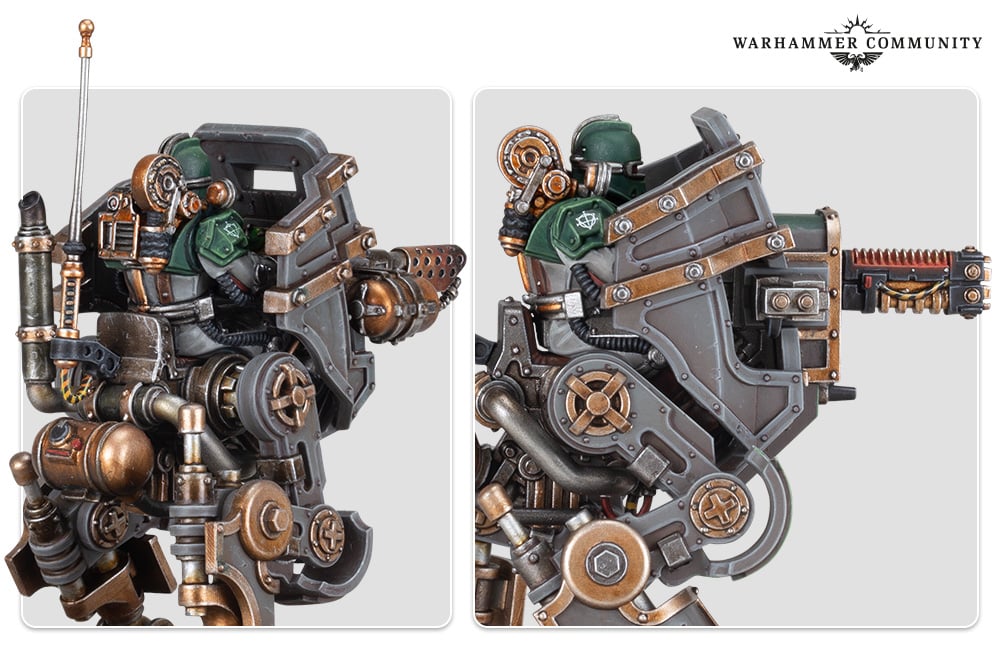
The big shield on the Veletaris version of the Sentinel gives it a 3+ save but drops its speed to 8”. They have BS4 so their volkite calivers will hit more than the standard Hermes’ multilaser, and do a bit more damage. You can replace that with a heavy flamer but I don’t think they’re a great platform for those, with their average-ish speed and weak melee profile.
They are an elite choice of two to six models and you have the interesting option, thanks to their Storm Section rule, of including them in an Auxilia Veletaris Tercio. They replace one of the Storm Sections, including the compulsory one if you like. This means you can potentially take a Tercio that only includes a unit of these, plus a Vanguard section with Rotor Cannons if you want. They have the Tercio rule so will join in with reactions and will get Line if you have taken the Solar Pattern Cohort Doctrine, as that covers everything in the Tercio.
My own Solar Auxilia are Solar Pattern and I definitely want some of these to accompany them. They seem like a lot of fun.
Solar Auxilia Aethon Heavy Sentinel Squadron
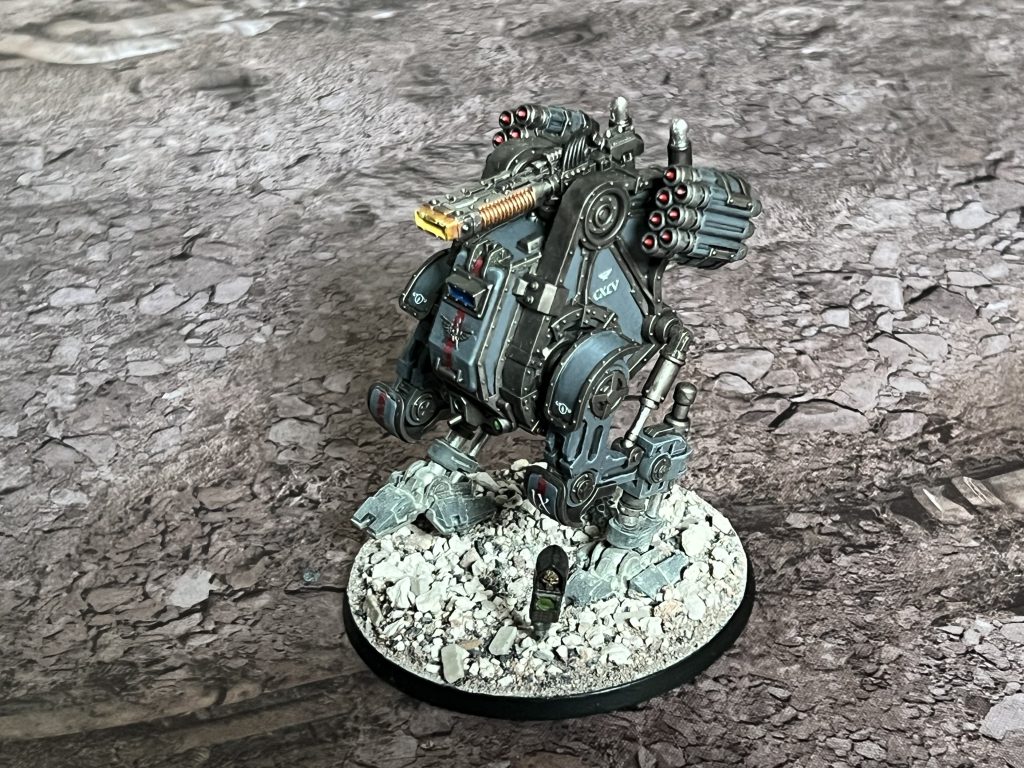
I’ve already reviewed this and the new model in detail. Check it out if you like.
Solar Auxilia Lifeward Section
Lifewards, Lifewards; so good they printed them twice. I’m as sure as I can be that there’s no difference between the two copies that we get in the book, having wasted literal minutes of my life checking back and forth between them. Here at Goonhammer Dot Com we have things called “editors” and while it is not given to the likes of me to understand their ways, I do find myself wondering if Games Workshop should get one.
New Special Characters
Horus Aximand
Little Horus has a standard Praetor’s stat line with some unique equipment and rules. His Warlord Trait automatically brings him back if he dies (though not from Instant Death) with D3 wounds remaining and grants a Shooting Phase reaction. He also has a Haunted special rule that gives you +1VP if his unit kills Garviel Loken, or +2 if Aximand kills him in a challenge – though obviously they aren’t going to meet all that often.
Mourn-it-all is a Paragon Blade that’s Master-crafted and gets 5+ Murderous Strike. It isn’t a specialist weapon but unfortunately he has a Castigatus Combat Shield, which prevents him from using two weapons. I think he should probably throw the shield away as it only gives him a 5++ (and he’s already got an Iron Halo) and reflects a S4 AP- hit back in melee if he passes an invulnerable save. Those S4 AP- hits aren’t likely to make any difference to an enemy who’s causing him to take invulnerable saves.
Tybalt Marr

“The Either” is another Sons of Horus Praetor. He’s a little bit cheaper than Little Horus and probably a bit better. He has Hatred (Shattered Legions), which I can certainly sympathise with. It won’t do much as you’re unlikely to ever meet Shattered Legions but it would be amazing if you did.
More relevant is that his Culling Blade has AP2, Fleshbane, Murderous Strike 6+ and isn’t a specialist weapon, so he gets 5 or 6 attacks with it. His Warlord Trait of forcing every enemy unit within 12″ to take a pinning test will sometimes be devastating, but not always as lots of things are either immune or just have sufficiently high LD to pass the test most of the time.
Hibou Khan
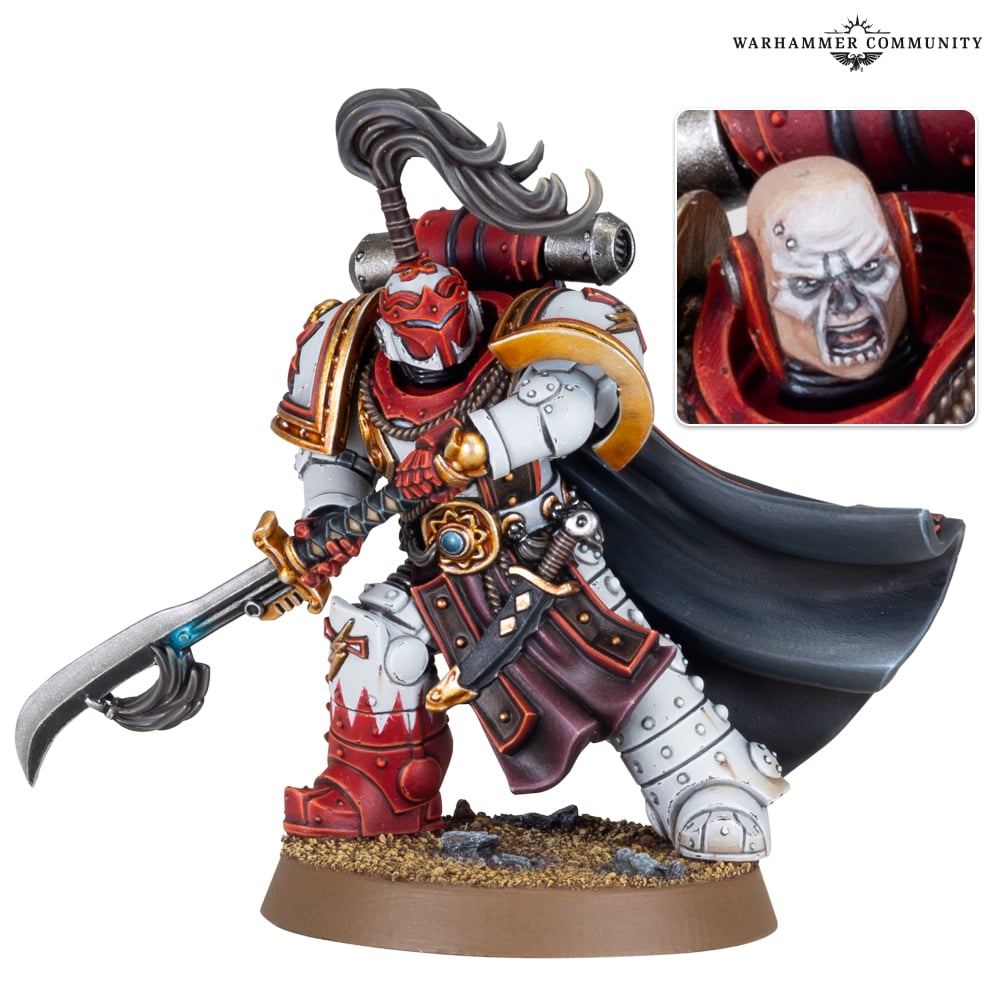
Hibou Khan is an outcast member of the White Scars Kharash. As such he’s really cool for leading a Sagyar Mazan White Scars force. He’s also allowed to be included in a Shattered Legions army but he’s not great for that, as the Kharash rule stops him from joining any of their units.
Rampage (2) for Hibou and his unit is excellent if you can find something that outnumbers them. I think the probable result of that would be that you massacre big units of tactical marines and Solar Auxilia but that it doesn’t trigger if you meet equivalent units of Legionaries, making it a “win more” ability. It’s excellent when it does come off.
Hibou’s stats are a Centurion with WS6, so he’s personally a bit weaker than most of the other characters here. His sword Breath of the Storm gets S6 and Breaching 4+ though, with Sudden Strike (1) and Murderous Strike (6+) so he will hurt things that he hits a lot. Nobody wants to be in a challenge with him, particularly since you don’t get VPs for killing him. You even keep your bonus reaction if he’s your Warlord and dies, though it switches from Movement to the Assault Phase
Shadrak Meduson
Meduson is a Praetor, though with only WS5. He has fairly average equipment of a rending bolter and fancy power sword (with AP3 but breaching 5+) but gets excellent special rules. These include Stubborn and Battle Hardened (1), helping him to stay in the fight for longer.
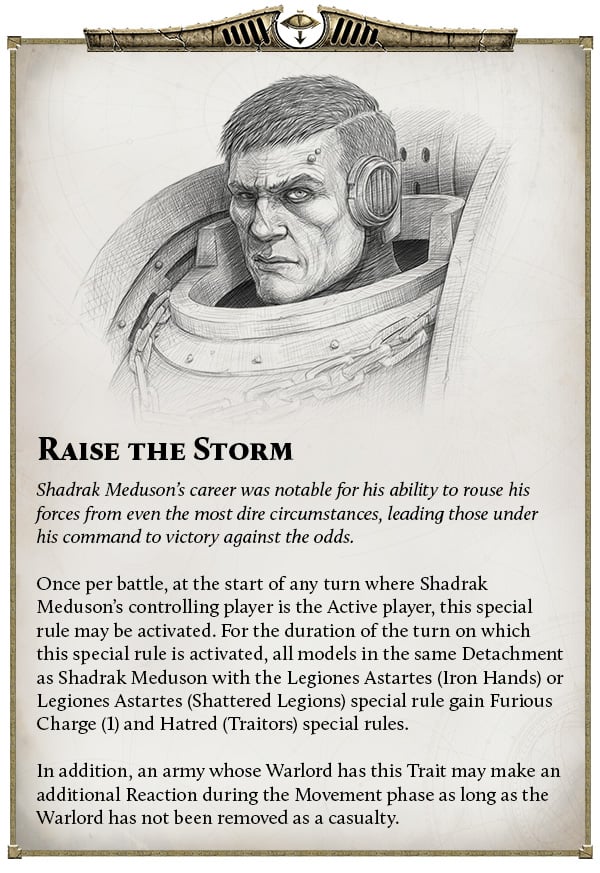
He can lead a Shattered Legion detachment or an Iron Hands one. Either way his Warlord Trait lets him give the whole detachment Furious Charge (1) and Hatred (Traitors) for a turn, once per game, and a bonus movement phase reaction. That’s a very impactful trait if you can line up a few charges at once. Even your tactical squads will hurt things, if they choose their targets sensibly.
Endryd Haar
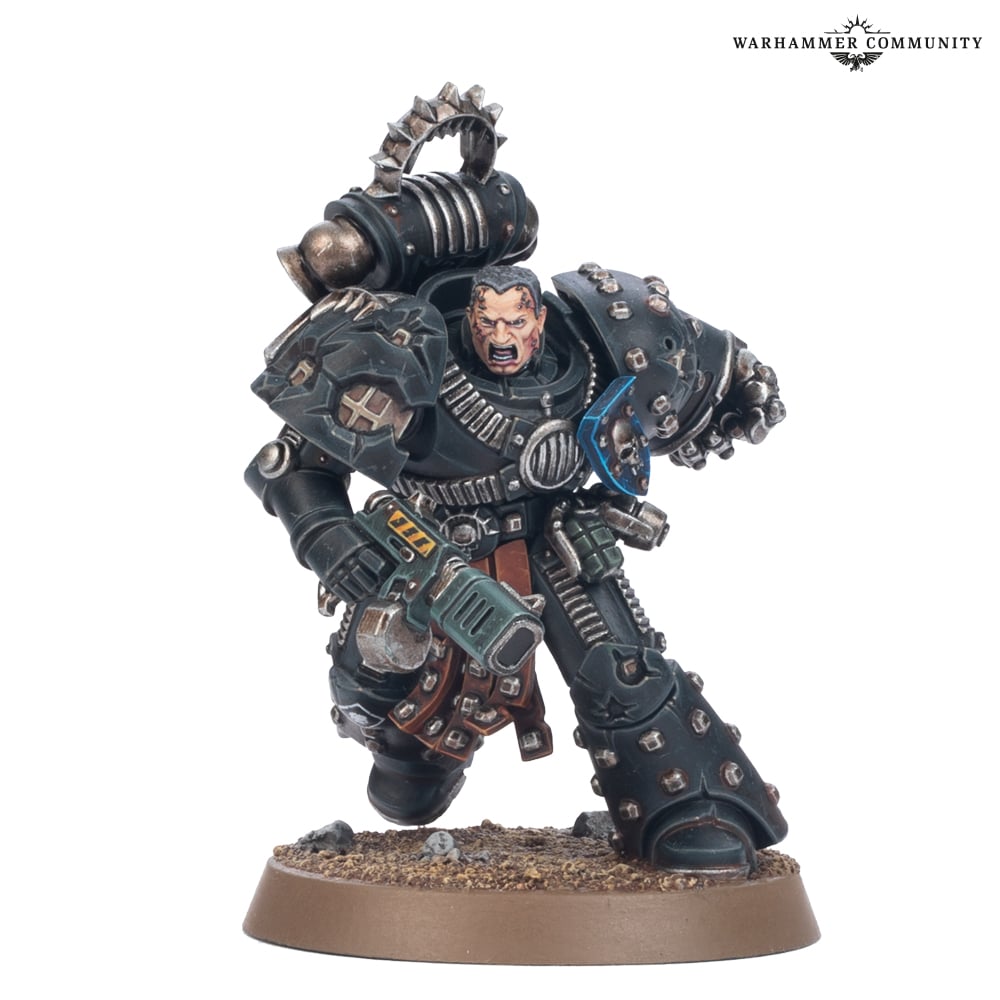
Unlike the other characters here, Haar has no legion and can only be taken as a Blackshield. He’s an absolute monster in melee and Khorne must be even more annoyed than usual to have missed out on having this guy as a servant.
Haar improves on the basic Praetor profile with T5, then goes further by adding Battle-hardened (1) and Hatred (World Eaters). He’s only BS4 with his Archeotech pistol, which doesn’t matter.
What does matter is his Terrawatt-pattern Power Gauntlet. This is basically a Power Fist with Brutal (2). If that wasn’t already enough you have the option of doing Charged Attacks, going from S8 to S12, though halving your attacks, rounding up.
His Warlord trait lets you give three units of non-Bulky Infantry Scout, which is excellent for getting early board control. I’d consider giving it to Tactical or Heavy Support squads, to establish early firing positions. Giving Scout to melee units can go wrong as you can’t charge on turn 1 even if you go second, though outflanking a melee unit can be a good option.
New Legion Units
Legiones Consularis: Overseer
The Overseer is a new type of Legion Consul for Legion Centurions. He’s a Support Squad so can’t be your compulsory HQ. He also gets the an Overseer’s Retinue and is a Master of Auxilia.
The Overseer’s retinue is either a Tercio of 1-3 Solar Auxilia Rifle Sections or 1-3 Militia Infantry Squads. They get the Legiones Auxilia rule corresponding with the Overseer’s Legion. Master of Auxilia makes him join one of his retinue squads and gives him that Legiones Auxilia rule as well.
I see the Overseer as a pure narrative choice. If you want to represent a marine leading Solar Auxilia, this guy does it. Otherwise you can just take a normal allied detachment and gain access to the rest of the Auxilia list.
Legion Optae
An Optae is an Independent Character with the profile of a Veteran. You can buy them most of the typical equipment Legion HQs can have, though it’ll all feel quite expensive for him. They have a Special Rule called Strength of the Legion, which lets their unit automatically regroup from being Broken and act normally that turn. Quite nice, but not likely to come up all that often.
This is an HQ you take either because you really want to save points on your compulsory HQ or for narrative reasons. It’s quite fun to imagine a junior legionary having to take command of a force because there was nobody else left. Otherwise he’s not that much cheaper than a Centurion but quite significantly worse. He only has normal power armour on – though Artificer is available – and no invulnerable save.
Legion Company Command Squad
This is a lot like the Legion Command Squad except that you can buy it to escort a Centurion or Optae rather than a Master of the Legion. It starts with four models instead of three and you can have up to nine, plus whatever character is leading the unit. They can buy a Company Standard, which is the same as a Legion Standard except it has a 6” aura of LD9 instead of 10. Unfortunately everyone is in normal power armour instead of Artificer and chainswords cost extra instead of coming as standard.
So another way of looking at this unit is as a Veteran Squad that has an attached Consul of some kind and which counts as Line so long as the standard bearer is alive – though note that you can’t give them the special or heavy weapons a Veteran Squad can have. You get the Veteran Squad’s transport options of Rhino, Drop Pod or Termite, which offers some interesting options for a reasonably tough unit with Line.
The Company Command Squad possibly highlights just what an amazing deal the Legion Command Squad is and it does look weak in comparison but in its own terms it’s a solid option. I thought it could provide some fun options for modelling up a unit to represent the retinue of a particular Consul too. Maybe they are trainee Chaplains or something like that, for example. Unfortunately, as our knowledgeable commenters have pointed out, Consuls don’t count as Centurions any more so they can’t have command squads.

Conclusion
This book, with the glaring exception of the Shattered Legion section, is really fine. Blackshields are crazy but they work, and they’ve done the basic stuff of giving them warlord traits and a reaction (unlike shattered legions). Legion Auxilia are a nice little bonus, though they do expose how little character the basic SA rules have. The new units are generally a bit weak but provide some fun new options. If it wasn’t for Shattered Legions this would be a perfectly serviceable book with new lore and options that flesh out the game. It’s still that if you skip past the Shattered Legion pages.
Have any questions or feedback? Drop us a note in the comments below or email us at contact@goonhammer.com.






You must be logged in to post a comment.